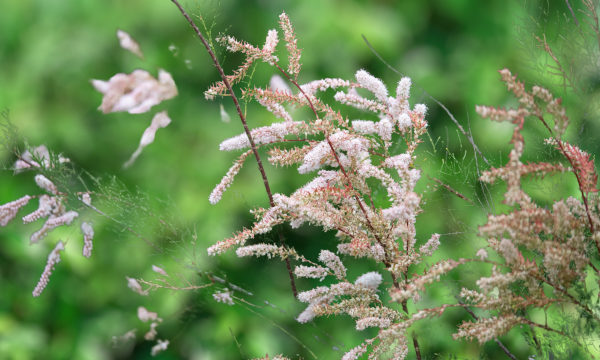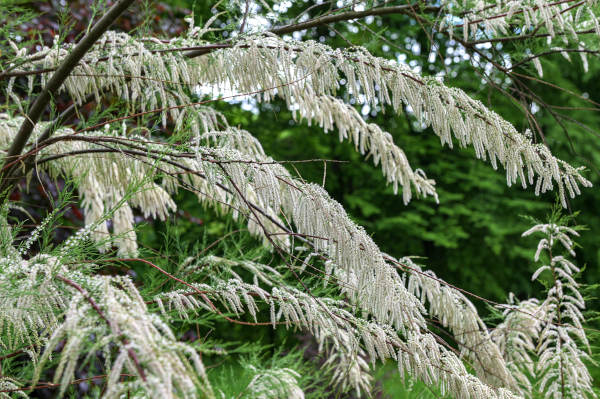How to grow Tamarix
Tamarix - also known as Tamarisk - is a genus made up of around 60 flowering plants. While native to Eurasia and Africa, there is plenty of variation in the family. Some Tamarix are evergreen, and others are deciduous shrubs and trees. From March to September, you are likely to see Tamarix flowers bloom in hues of white and pink stemming from the branches.
Interestingly, Tamarix - due to its native habit - has evolved to draw water from the soil and conserve this water. The plant is also naturally used to managing in salty conditions - which is where its other name, Salt Cedar, stems from. This unusual attribute makes Tamarix perfect for growing in gardens close to the sea, and its hardy nature also makes it the perfect windbreak.
Instead of forming wilting and dry leaves as Tamarix does in its native habitat, you are far more likely to see them beautifully nourished and dense plumes ranging from pale pink to vibrant darker reds in colour in the UK. Growing as tall as 8 metres in height, your Tamarix is sure to be the centrepiece of your garden - with scented blooms between summer and autumn bringing in a multitude of pollinators.

Key Information
Soil pH
Position
Hardiness


Where & when to plant Tamarix
Due to the hardy and wind-resistant nature of Tamarix, you have plenty of choices when it comes to finding the perfect spot for planting. Bear in mind the eventual size of it as a mature shrub or tree, as it can grow to 8 metres in both its height and spread. If you have a particularly windy or exposed garden, Tamarix can be planted to protect other plants from these conditions. You will need a position with well-drained soil and plenty of sunlight to get the best from your Tamarix. Plant in the autumn for the best results.
How to plant Tamarix
Prepare by digging a hole that’s 2-3 times the size of your Tamarix roots in your desired position. Remember to make sure your chosen site will get plenty of sunlight - ideally at least 6 hours per day
You might wish to add gravel or sand to the planting hole to help it to drain if the soil is heavy
Add the plant or roots to the hole with 6-8cm of room between the top of the root and the surface, and backfill the soil
Tamp the soil around the roots and water in the plant. You will need to water your Tamarix regularly for the first few weeks - after that, you can wait for the soil to dry a few inches down before watering again.

What to plant with Tamarix
As a natural windbreaker, your Tamarix can be used to protect smaller and more fragile plants in your garden from the elements. Due to Tamarix’s hardiness and salt resistance, it is also the perfect addition to a coastal garden theme. Try adding ornamental grasses such as the Stipa or Molinia, which sway beautifully in the breeze.
If you have exposed borders, a plant such as the Allium perfectly contrasts with the grass, while adding colour to your garden.



How to care for Tamarix
Pruning & Deadheading
To encourage better blooming, you should prune your Tamarix twice a year: once in the spring; and once after the summer bloom. This will help to boost flowering and train the shape of the plant.
Watering
Tamarix is used to thriving in conditions without much water and storing water in periods of drought. Initially, it is important to water to help establish growth - after this, you will only need to water if the soil is dry for several inches down. The Tamarix does not enjoy wet soil!
Cold Protection
While cold weather should not be too much of an issue, frost can be problematic for Tamarix if temperatures dip beneath -5°C. It may be wise to offer your plant some protection (horticultural fleece, deep mulch) if you live in colder parts of the UK.
Pests & Diseases
Tamarix may fall prey to common garden diseases such as powdery mildew, canker and wood rot. Regularly check the leaves of your Tamarix and be careful not to saturate the soil with water to prevent this.
How to propagate Tamarix
Progate Tamarix in the winter or early spring for best results. Remember to check for any disease or pests, and only take cuttings from healthy parts of the plant. Collect cuttings 10 to 15cm in length from any stems that haven’t formed hardwood yet using secateurs
Add cuttings to a small pot filled with cutting compost which has been mixed with grit or sand to improve drainage.
Keep the environment of the pot moist, warm and humid ensuring it is sited away from direct sunlight. You can add a plastic bag, cloche or covering over the pot to facilitate this.
After several weeks, your cutting(s) will be ready for repotting and growth!
Common Tamarix Questions
Is Tamarix fast-growing?
Yes, Tamarix is fast growing. It can grow to 18 metres in height in native conditions, and the tallest Tamarix has been recorded as 59 feet (18 metres) tall. Generally, in the UK, you are more likely to see them grow to 8 metres in height and spread.
How do you take care of Tamarix?
Tamarix needs plenty of water in the early stages of growth, as well as regular pruning to encourage longer-term blossoms throughout the year. You may also wish to cut Tamarix back to prevent it from becoming too tall, or to manage the shape of the shrub.
Is Tamarix hardy?
Yes, Tamarix is classified as a hardy perennial. Furthermore, it is tolerant to wind, salt, rain, drought and all sorts of conditions! Tamarix may, however, struggle in temperatures below -5°C.





